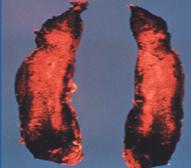Charcoal Rot: Macrophomina phaseolina
Symptoms
-
In the field, brown to black, water-soaked lesions appear on stems and petioles. Eventually, the stem may become watery and collapse, causing the ends of vines to wilt.
-
Usually, one or two vines may collapse, but occasionally the entire plant dies.
-
Charcoal rot, caused by the fungus, can cause losses of sweet potatoes in storage, but serious losses seldom occur. The disease is sometimes confused with black rot and Java black rot.
-
Symptoms in storage begin as a reddish brown to brown, firm, moist rot, initially restricted to the area just beneath the sweet potato skin.
-
As the decay progresses, the pathogen moves toward the center of the sweet potato, causing further rot. Two distinct zones become apparent within the infected tissue.
-
The leading edge continues as a reddish brown decay, and a zone of black develops behind the zone of active decay.
-
Although the lesions are sometimes restricted, charcoal rot usually consumes the entire root, which eventually dries, becoming hard and mummified.
Management
- Properly cure sweet potatoes immediately after harvest to reduce the incidence of charcoal rot.
|
|
Internal views of root with charcoal rot. |
|

